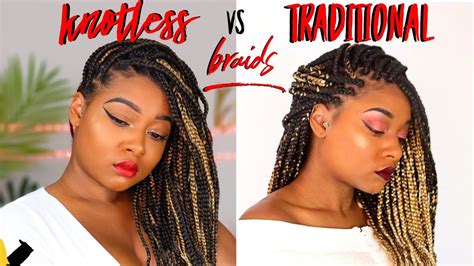Introduction
The world of protective hairstyles is vast and ever-evolving, with a plethora of options to choose from. Two of the most popular techniques are knotless braids and box braids. While both styles offer unique advantages, understanding their differences can help you make an informed decision for your next protective hairstyle.

What are Knotless Braids?
Knotless braids, also known as “invisible braids,” are a braiding method that eliminates the traditional knotting at the root. Instead, hair extensions are wrapped around the natural hair to create a seamless and natural-looking braid. The absence of knots makes these braids less prone to damage and allows for a more comfortable wear.
What are Box Braids?
Box braids are a classic braiding technique that involves dividing the hair into square sections and braiding them tightly with extensions. The braids are often large and chunky, giving the hairstyle a distinct and voluminous look. Box braids can be styled in various lengths and thicknesses to create a wide range of looks.
Comparison of Knotless and Box Braids
| Feature | Knotless Braids | Box Braids |
|---|---|---|
| Braid Root | No knots | Knotted |
| Tension | Less tension | More tension |
| Comfort | More comfortable | Less comfortable |
| Damage | Less damage | More potential for damage |
| Style | Natural-looking | Chunky and voluminous |
| Maintenance | Easier to maintain | Requires more maintenance |
Pros and Cons
Knotless Braids:
-
Pros:
- No knots at the root, reducing damage
- More comfortable to wear
- Natural-looking and versatile
-
Cons:
- Can be time-consuming to braid
- May not hold as long as box braids
Box Braids:
-
Pros:
- Classic and timeless style
- Versatile and can be styled in various ways
- Long-lasting when properly maintained
-
Cons:
- Knots can cause damage to hair
- Can be uncomfortable to wear
- Requires regular maintenance
Knotless vs. Box Braids: The Ideal Choice
The choice between knotless braids and box braids ultimately depends on your individual preferences and lifestyle. If you prioritize comfort, natural-looking braids, and reduced damage, knotless braids may be the better option. However, if you desire a classic, voluminous style that lasts for an extended period, box braids might be a more suitable choice.
Effective Strategies for Choosing the Right Style
- Consider your hair type and texture. Knotless braids are more suitable for fine or fragile hair, while box braids can handle thicker hair.
- Determine the desired look and comfort level. Knotless braids offer more versatility and comfort, while box braids provide a voluminous and textured style.
- Consult with a professional hair stylist. A licensed stylist can assess your hair and recommend the best braiding technique for your individual needs.
Step-by-Step Approach to Installing the Braids
Knotless Braids:
- Cleanse your hair and apply a leave-in conditioner.
- Divide your hair into small sections.
- Attach the extensions to the base of your natural hair using a wrapping technique.
- Braid the hair extension and your natural hair together.
- Continue braiding down the length of the hair.
Box Braids:
- Cleanse your hair and apply a detangling product.
- Divide your hair into square sections using a rattail comb.
- Feed the extension into the base of the hair and knot it securely.
- Braid the extension and your natural hair together.
- Repeat until all sections are braided.
Conclusion
Knotless and box braids offer distinct advantages and disadvantages, catering to different hair types and style preferences. By understanding the differences, pros, cons, and effective strategies for choosing the right style, you can confidently make a decision that enhances your beauty and protects your hair.
